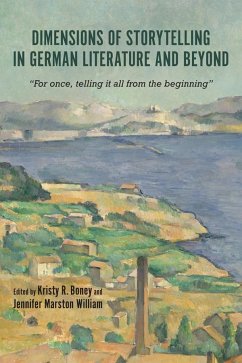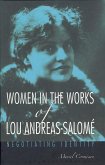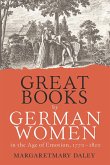Dimensions of Storytelling in German Literature and Beyond
For Once, Telling It All from the Beginning
Herausgeber: Kristy Boney, Kristy; William, Jennifer Marston
Dimensions of Storytelling in German Literature and Beyond
For Once, Telling It All from the Beginning
Herausgeber: Kristy Boney, Kristy; William, Jennifer Marston
- Gebundenes Buch
- Merkliste
- Auf die Merkliste
- Bewerten Bewerten
- Teilen
- Produkt teilen
- Produkterinnerung
- Produkterinnerung
Explores the storytelling of Anna Seghers and other 20th-century writers who faced the tensions between aesthetics and politically conscious writing, between conformity and resistance.
Andere Kunden interessierten sich auch für
![Women and German Drama Women and German Drama]() Sarah ColvinWomen and German Drama116,99 €
Sarah ColvinWomen and German Drama116,99 €![Women in the Works of Lou Andreas-Salomé Women in the Works of Lou Andreas-Salomé]() Muriel CormicanWomen in the Works of Lou Andreas-Salomé129,99 €
Muriel CormicanWomen in the Works of Lou Andreas-Salomé129,99 €![Women Peasant Poets in Eighteenth-Century England, Scotland, and Germany Women Peasant Poets in Eighteenth-Century England, Scotland, and Germany]() Susanne KordWomen Peasant Poets in Eighteenth-Century England, Scotland, and Germany152,99 €
Susanne KordWomen Peasant Poets in Eighteenth-Century England, Scotland, and Germany152,99 €![Edinburgh German Yearbook 11 Edinburgh German Yearbook 11]() Edinburgh German Yearbook 1194,99 €
Edinburgh German Yearbook 1194,99 €![Novels of Turkish German Settlement Novels of Turkish German Settlement]() Tom CheesmanNovels of Turkish German Settlement116,99 €
Tom CheesmanNovels of Turkish German Settlement116,99 €![Edinburgh German Yearbook 10 Edinburgh German Yearbook 10]() Edinburgh German Yearbook 10129,99 €
Edinburgh German Yearbook 10129,99 €![Great Books by German Women in the Age of Emotion, 1770-1820 Great Books by German Women in the Age of Emotion, 1770-1820]() Margaretmary DaleyGreat Books by German Women in the Age of Emotion, 1770-1820152,99 €
Margaretmary DaleyGreat Books by German Women in the Age of Emotion, 1770-1820152,99 €-
-
-
Explores the storytelling of Anna Seghers and other 20th-century writers who faced the tensions between aesthetics and politically conscious writing, between conformity and resistance.
Hinweis: Dieser Artikel kann nur an eine deutsche Lieferadresse ausgeliefert werden.
Hinweis: Dieser Artikel kann nur an eine deutsche Lieferadresse ausgeliefert werden.
Produktdetails
- Produktdetails
- Verlag: Boydell & Brewer
- Seitenzahl: 290
- Erscheinungstermin: 20. Dezember 2018
- Englisch
- Abmessung: 152mm x 231mm x 23mm
- Gewicht: 612g
- ISBN-13: 9781640140400
- ISBN-10: 1640140409
- Artikelnr.: 53534809
- Herstellerkennzeichnung
- Libri GmbH
- Europaallee 1
- 36244 Bad Hersfeld
- 06621 890
- Verlag: Boydell & Brewer
- Seitenzahl: 290
- Erscheinungstermin: 20. Dezember 2018
- Englisch
- Abmessung: 152mm x 231mm x 23mm
- Gewicht: 612g
- ISBN-13: 9781640140400
- ISBN-10: 1640140409
- Artikelnr.: 53534809
- Herstellerkennzeichnung
- Libri GmbH
- Europaallee 1
- 36244 Bad Hersfeld
- 06621 890
Kristy R. Boney, Jennifer Marston William
Introduction: The Social, Political, and Personal Dimensions of
Storytelling - Kristy R. Boney and Jennifer Marston William PART I. ANNA
SEGHERS: A MISSING PIECE IN THE CANON OF MODERNIST STORYTELLERS Anna
Seghers in Heidelberg: The Formative Years - Christiane Zehl Romero Who Is
the Narrator? Anna Seghers's "The Excursion of the Dead Girls": Narrative
Mode and Cinematic Depiction - Peter Beicken Anna Seghers's Rubble
Literature, 1947-49 - Ute Brandes Anna Seghers and the Struggle to Tell
Stories about the Nazi Past in the Early German Democratic Republic -
Stephen Brockmann Aufbauzeit or flaue Zeit? Anna Seghers's GDR Novels -
Hunter Bivens The Time of Decision in Anna Seghers - Benjamin Robinson
Filling the Void with Stories: Anna Seghers's Conceptual Metaphors -
Jennifer Marston William PART II. EXPRESSIONS OF MODERNITY: USING
STORYTELLING UNCONVENTIONALLY Storytelling and Telling Stories in Heine's
Prose Fiction - Robert C. Holub Modernist Haze: Topographical Textures in
Paul Klee and Franz Kafka - Kristy R. Boney Synthesis and Transtextuality:
The Jewish Reinvention of Chinese Mythical Stories in "Shanghai Ghetto" -
Weijia Li American Children Writing Yiddish: The Published Anthologies of
the Chicago Sholem Aleichem Schools - Elizabeth Loentz A Literary Depiction
of the Homeland of Jews in Czechoslovakia and East Germany after 1945 -
Michaela Peroutkova Changed for the Better? Alternative Uses of the
Transformative Cancer Trope in Thomas Mann's Die Betrogene and Nadine
Gordimer's Get a Life - Kristen Hetrick PART III. THE PERSONAL NARRATIVE:
STORYTELLING IN ACUTE HISTORICAL MOMENTS Problems and Effects of
Autobiographical Storytelling: Als Pimpf in Polen: Erweiterte
Kinderlandverschickung 1940-1945 (1993) and A Hitler Youth in Poland: The
Nazis' Program for Evacuating Children during World War II (1998) - Jost
Hermand Too Near, Too Far: My GDR Story - Marc Silberman Conflict without
Resolution: Konrad Wolf and the Dilemma of Hatred - Andy Spencer "Bleibt
noch ein Lied zu singen": Autobiographical and Cultural Memory in Christa
Wolf's Novel Kindheitsmuster - Luke Springman Narrating Germany's Past: A
Story of Exile and the Return Home-A Translation of the Chapter "Above the
Lake" from Ursula Krechel's Novel Landgericht - Amy Kepple Strawser
Storytelling in the GDR: An Interview with Eberhard Aurich and Christa
Streiber-Aurich - Sylvia Fischer Notes on the Contributors
Storytelling - Kristy R. Boney and Jennifer Marston William PART I. ANNA
SEGHERS: A MISSING PIECE IN THE CANON OF MODERNIST STORYTELLERS Anna
Seghers in Heidelberg: The Formative Years - Christiane Zehl Romero Who Is
the Narrator? Anna Seghers's "The Excursion of the Dead Girls": Narrative
Mode and Cinematic Depiction - Peter Beicken Anna Seghers's Rubble
Literature, 1947-49 - Ute Brandes Anna Seghers and the Struggle to Tell
Stories about the Nazi Past in the Early German Democratic Republic -
Stephen Brockmann Aufbauzeit or flaue Zeit? Anna Seghers's GDR Novels -
Hunter Bivens The Time of Decision in Anna Seghers - Benjamin Robinson
Filling the Void with Stories: Anna Seghers's Conceptual Metaphors -
Jennifer Marston William PART II. EXPRESSIONS OF MODERNITY: USING
STORYTELLING UNCONVENTIONALLY Storytelling and Telling Stories in Heine's
Prose Fiction - Robert C. Holub Modernist Haze: Topographical Textures in
Paul Klee and Franz Kafka - Kristy R. Boney Synthesis and Transtextuality:
The Jewish Reinvention of Chinese Mythical Stories in "Shanghai Ghetto" -
Weijia Li American Children Writing Yiddish: The Published Anthologies of
the Chicago Sholem Aleichem Schools - Elizabeth Loentz A Literary Depiction
of the Homeland of Jews in Czechoslovakia and East Germany after 1945 -
Michaela Peroutkova Changed for the Better? Alternative Uses of the
Transformative Cancer Trope in Thomas Mann's Die Betrogene and Nadine
Gordimer's Get a Life - Kristen Hetrick PART III. THE PERSONAL NARRATIVE:
STORYTELLING IN ACUTE HISTORICAL MOMENTS Problems and Effects of
Autobiographical Storytelling: Als Pimpf in Polen: Erweiterte
Kinderlandverschickung 1940-1945 (1993) and A Hitler Youth in Poland: The
Nazis' Program for Evacuating Children during World War II (1998) - Jost
Hermand Too Near, Too Far: My GDR Story - Marc Silberman Conflict without
Resolution: Konrad Wolf and the Dilemma of Hatred - Andy Spencer "Bleibt
noch ein Lied zu singen": Autobiographical and Cultural Memory in Christa
Wolf's Novel Kindheitsmuster - Luke Springman Narrating Germany's Past: A
Story of Exile and the Return Home-A Translation of the Chapter "Above the
Lake" from Ursula Krechel's Novel Landgericht - Amy Kepple Strawser
Storytelling in the GDR: An Interview with Eberhard Aurich and Christa
Streiber-Aurich - Sylvia Fischer Notes on the Contributors
Introduction: The Social, Political, and Personal Dimensions of
Storytelling - Kristy R. Boney and Jennifer Marston William PART I. ANNA
SEGHERS: A MISSING PIECE IN THE CANON OF MODERNIST STORYTELLERS Anna
Seghers in Heidelberg: The Formative Years - Christiane Zehl Romero Who Is
the Narrator? Anna Seghers's "The Excursion of the Dead Girls": Narrative
Mode and Cinematic Depiction - Peter Beicken Anna Seghers's Rubble
Literature, 1947-49 - Ute Brandes Anna Seghers and the Struggle to Tell
Stories about the Nazi Past in the Early German Democratic Republic -
Stephen Brockmann Aufbauzeit or flaue Zeit? Anna Seghers's GDR Novels -
Hunter Bivens The Time of Decision in Anna Seghers - Benjamin Robinson
Filling the Void with Stories: Anna Seghers's Conceptual Metaphors -
Jennifer Marston William PART II. EXPRESSIONS OF MODERNITY: USING
STORYTELLING UNCONVENTIONALLY Storytelling and Telling Stories in Heine's
Prose Fiction - Robert C. Holub Modernist Haze: Topographical Textures in
Paul Klee and Franz Kafka - Kristy R. Boney Synthesis and Transtextuality:
The Jewish Reinvention of Chinese Mythical Stories in "Shanghai Ghetto" -
Weijia Li American Children Writing Yiddish: The Published Anthologies of
the Chicago Sholem Aleichem Schools - Elizabeth Loentz A Literary Depiction
of the Homeland of Jews in Czechoslovakia and East Germany after 1945 -
Michaela Peroutkova Changed for the Better? Alternative Uses of the
Transformative Cancer Trope in Thomas Mann's Die Betrogene and Nadine
Gordimer's Get a Life - Kristen Hetrick PART III. THE PERSONAL NARRATIVE:
STORYTELLING IN ACUTE HISTORICAL MOMENTS Problems and Effects of
Autobiographical Storytelling: Als Pimpf in Polen: Erweiterte
Kinderlandverschickung 1940-1945 (1993) and A Hitler Youth in Poland: The
Nazis' Program for Evacuating Children during World War II (1998) - Jost
Hermand Too Near, Too Far: My GDR Story - Marc Silberman Conflict without
Resolution: Konrad Wolf and the Dilemma of Hatred - Andy Spencer "Bleibt
noch ein Lied zu singen": Autobiographical and Cultural Memory in Christa
Wolf's Novel Kindheitsmuster - Luke Springman Narrating Germany's Past: A
Story of Exile and the Return Home-A Translation of the Chapter "Above the
Lake" from Ursula Krechel's Novel Landgericht - Amy Kepple Strawser
Storytelling in the GDR: An Interview with Eberhard Aurich and Christa
Streiber-Aurich - Sylvia Fischer Notes on the Contributors
Storytelling - Kristy R. Boney and Jennifer Marston William PART I. ANNA
SEGHERS: A MISSING PIECE IN THE CANON OF MODERNIST STORYTELLERS Anna
Seghers in Heidelberg: The Formative Years - Christiane Zehl Romero Who Is
the Narrator? Anna Seghers's "The Excursion of the Dead Girls": Narrative
Mode and Cinematic Depiction - Peter Beicken Anna Seghers's Rubble
Literature, 1947-49 - Ute Brandes Anna Seghers and the Struggle to Tell
Stories about the Nazi Past in the Early German Democratic Republic -
Stephen Brockmann Aufbauzeit or flaue Zeit? Anna Seghers's GDR Novels -
Hunter Bivens The Time of Decision in Anna Seghers - Benjamin Robinson
Filling the Void with Stories: Anna Seghers's Conceptual Metaphors -
Jennifer Marston William PART II. EXPRESSIONS OF MODERNITY: USING
STORYTELLING UNCONVENTIONALLY Storytelling and Telling Stories in Heine's
Prose Fiction - Robert C. Holub Modernist Haze: Topographical Textures in
Paul Klee and Franz Kafka - Kristy R. Boney Synthesis and Transtextuality:
The Jewish Reinvention of Chinese Mythical Stories in "Shanghai Ghetto" -
Weijia Li American Children Writing Yiddish: The Published Anthologies of
the Chicago Sholem Aleichem Schools - Elizabeth Loentz A Literary Depiction
of the Homeland of Jews in Czechoslovakia and East Germany after 1945 -
Michaela Peroutkova Changed for the Better? Alternative Uses of the
Transformative Cancer Trope in Thomas Mann's Die Betrogene and Nadine
Gordimer's Get a Life - Kristen Hetrick PART III. THE PERSONAL NARRATIVE:
STORYTELLING IN ACUTE HISTORICAL MOMENTS Problems and Effects of
Autobiographical Storytelling: Als Pimpf in Polen: Erweiterte
Kinderlandverschickung 1940-1945 (1993) and A Hitler Youth in Poland: The
Nazis' Program for Evacuating Children during World War II (1998) - Jost
Hermand Too Near, Too Far: My GDR Story - Marc Silberman Conflict without
Resolution: Konrad Wolf and the Dilemma of Hatred - Andy Spencer "Bleibt
noch ein Lied zu singen": Autobiographical and Cultural Memory in Christa
Wolf's Novel Kindheitsmuster - Luke Springman Narrating Germany's Past: A
Story of Exile and the Return Home-A Translation of the Chapter "Above the
Lake" from Ursula Krechel's Novel Landgericht - Amy Kepple Strawser
Storytelling in the GDR: An Interview with Eberhard Aurich and Christa
Streiber-Aurich - Sylvia Fischer Notes on the Contributors








